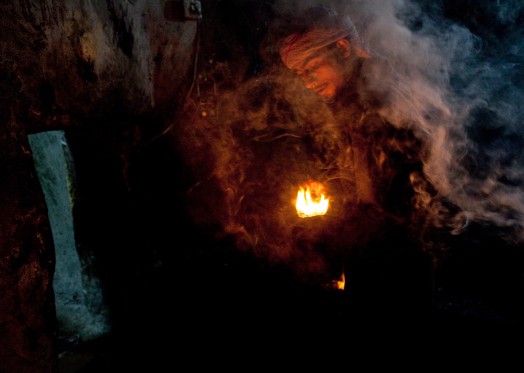Yazidis’ holy land

Past the small peshmerga check point the road winds up a narrow valley tucked away in the sparsely forested hills of northern Kurdistan. Rocks engraved with symbols representing the sun pave the way leading to Lalish, the sacred mountain hamlet that is to the Yazidis what Mecca is to Muslims, or what Jerusalem is for Jews and Christians: the holiest site of one of the oldest religions on Earth.
Their calendar begins ages before the Hebrew one, and all along their history Yazidis suffered spates of recurrent pogroms and persecutions: most recently the massacre of their community in Sinjar, where entire villages have been bombed to rubble and thousands have been murdered by Isis’ cutthroats, while girls were raped and sold into slavery.
The Islamic Caliphate is just 50 miles away from Lalish, yet the temple complex is immersed in a quite, peaceful mood. Children play in the courtyards, shaded by gigantic mulberry trees. Women in bright colorful clothings draw crystal-clear water from the springs. Elders in traditional attires get ready for the daily rituals under the conical pyramid-like roofs of the temple.
Surur, a “servant of the house”, one of the only 25 people permitted to live permanently in the hamlet, introduces me to Baba Chawish, a holy man. “Our villages are a battleground” says the white-clad spiritual leader. “The survivors are stranded in refugee camps, or scattered in the mountains without any shelter. But we are determined to protect our shrines”.
He tries to explain me the esoteric mystics of his faith, which predates Islam and Christianity: a blend of Zoroastrianism, Sufism, ancient Persian and Mesopotamian cults, centered around seven angels led by Tawsi Malik, also known as Peacock Angel or Shaytan-Satan. They pray facing the sun. They don’t accept converts and cannot leave their religion. They believe in reincarnation and abide to a strict cast system.
I remove my shoes, pass through the carved temple portal adorned with an image of a snake and enter the cavernous shrine. There are two massive tombs in the main hall, draped in sheets of red and green fabric. A third tomb in an inner chamber, wrapped in red velvet and damask, holds the revered body of Sheik Adi ibn Musafir, a possible reincarnation of Tawsi Malik who moved to Kurdistan from Baghdad in the XII century. The walls are ringed with colorful knotted scarves, each knot representing a prayer or a pilgrim’s offer. But all colors desappear as one descends deeper into the womb of the sacred caves. The rocky walls and the stones are pitch black, covered by a greasy time’s coating. And the rancid smell of olive oil exhales from an endless row of blackened urns.
Suddenly, as the sun sets, everyone leaves. And the fire lits up. Followed by a helper who spreads thick clouds of incense, a young man is sent running in the temple. Hands soaked in oil, he rushes through the halls and the caves igniting more than six hundred candlewicks: each of them to be hanged on just as many symbolic spots. So that the sacred Yazidis’ light can burn, even when Lalish sinks into the night.





